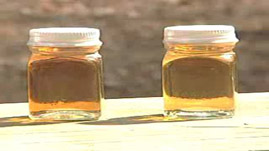Teachers' Domain - Digital Media for the Classroom and Professional Development
User: Preview

Source: Outside
In this video from WPSU’s Outside, a staff member from the Shaver's Creek Environmental Center at Penn State University shows how to identify a sugar maple by its branches, twigs, buds, and bark. He then explains how to tap the sugar maple and collect the sap. Finally, he describes the techniques used in maple syrup production, many of which date back to the methods of Native Americans and early settlers in America.
Maple syrup production is one of America’s oldest crops. The tradition of producing maple syrup began with Native Americans who passed their skill onto early settlers. Many of the same techniques are used today, allowing consumers to make small amounts of their own syrup.
The first step in maple sugaring is to locate a sugar maple tree. Since sugaring takes place in cold months, the harvester needs to be able to recognize the tree without its characteristic leaves. Sugar maple can be identified by its opposite branches and brown twigs with a sharp terminal bud. The older bark close to the ground is coarse and irregular, while the bark further up in the younger part of the tree is smoother with some warts.

Materials courtesy of Pennsylvania State University.
Once sugar maples have been identified, the harvester selects a tree that is at least ten inches in diameter, and drills a hole at a slight, upward angle about one and a half inches deep. A tap is inserted with a few light strokes from a mallet. A tube is connected to the tap and sap drains into a container. Sap is the watery fluid that circulates through a plant.
Why does maple sugaring take place in early spring? The sap that oozes from the tap is responding to pressure from water-conducting tissue in the maple stem, or xylem. When the weather is below freezing at night, and the days are warm, maple stems undergo a freeze-thaw cycle. During the cold period, gases in the xylem dissolve, stem pressure decreases, and the stem absorbs water from surrounding cells. The water freezes inside the hollow xylem, compressing and trapping the dissolved gases. When the stem warms up, the ice-locked gases expand, forcing out the sap.
The heart of maple syrup production is the boiling-down process. About 40 gallons of sap produce one gallon of syrup. The amount of sugar in the sap varies from season to season, as does the color. Commercial vendors grade maple syrup based on the color, but the grade has nothing to do with the nutritional quality of the syrup. Also, it’s a matter of personal preference which grade or color tastes better.
Sugar maples are cold-weather trees found commonly in New England and the Great Lakes states, and in several Canadian provinces. As global warming occurs, the area for producing maple syrup will move further north. Since trees that produce sap must be 40 to 50 years old, producers of maple syrup must look ahead to where they can cultivate stands of sugar maples in the future.
To learn about different types of sweeteners, check out Cooking with Sugar.
To learn about edible parts of plants, check out Supermarket Botany.
For more information about the form and function of trees, check out Shape of Things: Trees.
 Loading Standards
Loading Standards